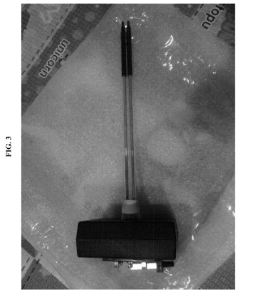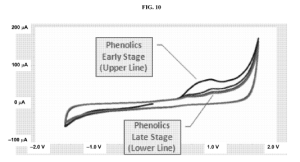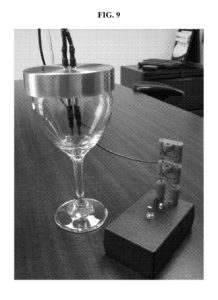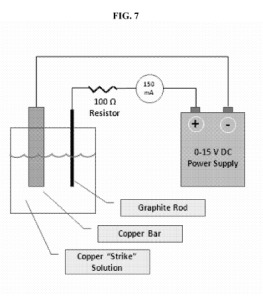“Wine Technology of the Future” is a series on The Academic Wino that features new inventions and patents that attempt to make your wine experience easier and more enjoyable. Previously on this series, we’ve introduced the “self-aerating wine bottle”; the “corkscrew with integral intelligent thermometer”; “wine dispensing and preservation device”; “multi-stream wine aerating device” (plus follow-up review of the prototype); the “wine bag carrier”, the “system and method for pairing food with wine”, the “lateral flow device for Botrytis cinerea detection”, the “wine bottle with permanent contact between the wine and the cork”, the “straw for wine”, and most recently, the “SmartWine Cloud Tech system“. Click on any one of the names to read the associated post.
Today’s invention, which was brought to my attention by one of our readers, is the “Device for Accelerated Aging of Wine”, invented by Ronald C. Stites, Erik J., Stites, David Gill, Andrew Benwell, and Stephen, M. Stites, from Colorado, Utah, California, and Missouri. The patent was filed on December 29th, 2014, and was recently granted and published on July 2nd, 2015.
According to the patent (US 2015/0184117 A1), the “Device for Accelerated Aging of
Wine” is meant to do just that—accelerate the aging of wine! To be more specific, this device was created to help winemakers speed up the natural process of wine aging so that their wines may be at preferred “drinkable” stage sooner and thus allowing the wineries to sell their product at an earlier date, reducing the cost of storage associated with long aging times.
Why Age Wine?
Certain beverages, specifically red wine, often require a resting period or extended aging time in order to mature and develop into a complex and high quality wine. Specifically, young red wines are often loaded with highly astringent tannin compounds that over time evolve and react with other compounds in the wine and oxygen in the bottle to soften and create a more palatable and enjoyable drinking beverage.
Though admittedly there are some people who love that big bite of a young red wine, traditionally speaking it’s the softer, aged wines that winemakers desire and the type that most wineries would prefer to hold off on releasing until sufficient time has passed to sell to customers in order to provide them with a high quality representation of what the winery is capable of producing.
In natural aging, the chemical process that results in a softer, more palatable wine is dependent upon several factors, including the pH of the wine, how much oxygen is present in the wine and in the headspace of the bottle, what types of organic compounds are present in the wine, and how the wine is stored (including temperature, light, bottle type, etc.). According to the patent, the chemical reactions that occur in natural aging that help the wine evolve happen spontaneously, started by some sort of “random energetic event”
like radiation or natural radioactivity, creating the free radicals necessary for subsequent chemical reactions.
Chemically and physically speaking, those compounds and molecules that are responsible for various flavors and aromas in wine are “free-radical reactive”, meaning that if there are free radicals present in the wine, they are going to react with those flavor compounds and molecules and ultimately change the taste and smell of the wine over time. This all occurs naturally, though the timing of it is not well understood and is markedly different from wine to wine.
How to Speed Things Up
The inventors of the “Device for Accelerated Aging of Wine” aimed to take some of the unpredictability out of natural wine aging and attempted to speed up the process by harnessing these free radical reactions in a way that they could control (at least somewhat).
Basically, the inventors needed a way to create free radicals in the wine to give it a jump start on the aging process, and one way to do that utilizing some basic physics principles. Specifically, one method for this that has been studied is using AC-pulsed electric fields. Some initial problems, however, with past research is that using pulsed electric fields at the time were very expensive, and also ran into the problem of wasting electricity and sometimes actually heating the wine due to the very high voltage running through it.
The Device For Accelerated Aging of Wine
In order to address some of the problems plaguing pulsed electric field use for aging of
wine in the past, the inventors opted to create a small, portable DC (direct current) device that could be used in varying volumes of wine. By using DC instead of AC current, the inventors were able to create a small enough device to be able to fit into a bottle or a glass of wine, and minimize the amount of voltage used, energy lost, and heat produced.
In its most basic form, the “Device for Accelerated Aging of Wine” consists of a DC current and voltage controller, which are connected to both a positive and negative electrode which when are connected to a substance (in this case, the wine), the current is complete and electricity may run through it. There is also a switch for controlling when electricity is flowing, as well as a connection to a power source (via a plug or a battery pack). The device also has the ability to be portable, in which case a wireless controller would be used instead of a plug or battery pack. Finally, the device could also have the ability to determine how “aged” the wine is already, by using a computer program or programmable computer chip.
How the device works is that you would basically select the volume of wine that you want to age, stick the positive and negative electrode end into the wine, flip the switch so electricity flows into the wine thus creating free radicals, and then treating the wine for a certain period of time (between 1 and 60 minutes) in order to achieve the desired “aged” level. This low voltage current creates free radicals, which then react with the compounds in the wine and precipitate out the tannins and other polyphenols that are responsible for creating the astringency taste/feeling in the wine.
By selecting the volume of wine you are treating, the amount of electricity flowing through the device will change. Specifically, if you’re just treating a glass of wine, you’ll need significantly less electricity (amps or microamps) running through the liquid than if you were treating a whole bottle or a much larger vessel.
Concluding Thoughts
This device does sound interesting and in theory could work well in altering the chemical composition of the treated wine such that the taste, flavors, and aromas are changed after treatment. I would be more convinced if I could see actual peer-reviewed data on this exact device, in order to see chemically how the wine has changed, and how similar (or different) it may be from naturally aged wines. The inventors also claim to be able to reduce the sulfur content of the wine, which I’m assuming also utilizes this electricity-induced free radical formation and reaction, the data of which I would definitely love to see.
In terms of how the device works, one question I have is how much “precipitate” are we talking? Recall, the low-voltage electric treatment on the wine creates free radicals that react with the wine and ultimately ends with the precipitation of tannins and other polyphenols. Does this mean there will be a bunch of solid “gunk” at the bottle of the glass or bottle? Decanting the bottle would certainly take care of the problem, but what if it’s in
a glass? How easy is it to just pour the wine into a new glass without mixing the precipitate formed at the bottom (or does that not even matter)? Maybe it’s so little that it is barely noticeable to the consumer? I’d like to see more data on this.
According to the reader who sent this patent to me, they are currently demonstrating this device in wineries, and he said that everyone he talked to was excited about the device and excited about how the wine tasted after the treatment. So, I do know that it MIGHT be available for purchase on the market, or at the very least it’s out there being demonstrated in wineries. While it sounds like it’s currently being marketed toward wineries, I wonder if they will be producing a version of this “Device for Accelerated Aging of Wine” that can be used at home. The patent seems to indicate that it could be, though I’m not sure where they are in the development of that size device.
Overall, it sounds pretty cool and something I’d 1) want to see actual scientific comparison data for and 2) want to play around with using the miniaturized version when and if they make those available!
What do you all think of this invention? Are you one of the few to see this bad boy in action? Please feel free to leave your comments!
Source: US Patent 2015/0184117 A1





3 comments for “Wine Technology of the Future: The Device For Accelerated Aging of Wine”